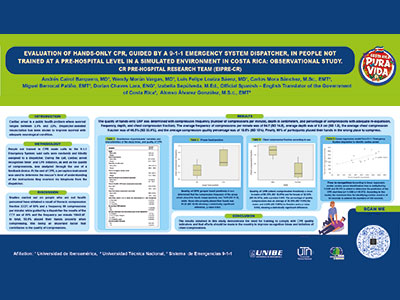ABSTRACTS
Evaluation of Hands-Only CPR Guided by a 9-1-1 Emergency System Dispatcher in People Not Trained at a Prehospital Level in a Simulated Environment in Costa RicaAuthor: Andres Cairol, Wendy Morun, Luis Felipe Loaiza, Carlos Mora, Miguel Berrocal, Dorian Chaves, Alonso Alvarez, and Izabella Sepulveda | | Associate Authors:
Introduction: Cardiac arrest is a public health problem with survival ranging between 2.4% and 22%. Dispatcher-assisted resuscitation has been shown to improve survival with adequate neurological condition. Objective: To evaluate hands-only CPR guided by a 9-1-1 emergency system dispatcher in people not trained at a prehospital level in a simulated environment in Costa Rica. Methodology: People not trained in CPR made calls to the 9-1-1 system and were assigned randomly and blindly to a dispatcher. During the call, time of recognition of cardiac arrest, initiation of CPR, and quality of compressions were analyzed through the use of a feedback device. At the end of CPR, a perception instrument was used to determine the rescuer's level of understanding of the instructions they received via telephone from the dispatcher. Results: The average compression frequency was 84.7 (SD = 14.8) per minute, the average compression depth was 3.8 cm (SD = 1.3), the average chest compression fraction was 48.5% (SD = 33.6%), and the average compression quality was 10.5% (SD = 13%). Sixty percent of participants placed their hands in the wrong place to compress. The mean cardiac arrest identification time was 104.1 seconds (SD = 39.1), the mean initiation of dispatcher-guided CPR was 212 seconds (SD = 70.6), and only 15% of scenarios met the maximum target times. Conclusion: The results obtained in this study demonstrate the need for training to comply with CPR quality indicators. Efforts should be made in Costa Rica to improve recognition times and initiation of chest compressions.
|

